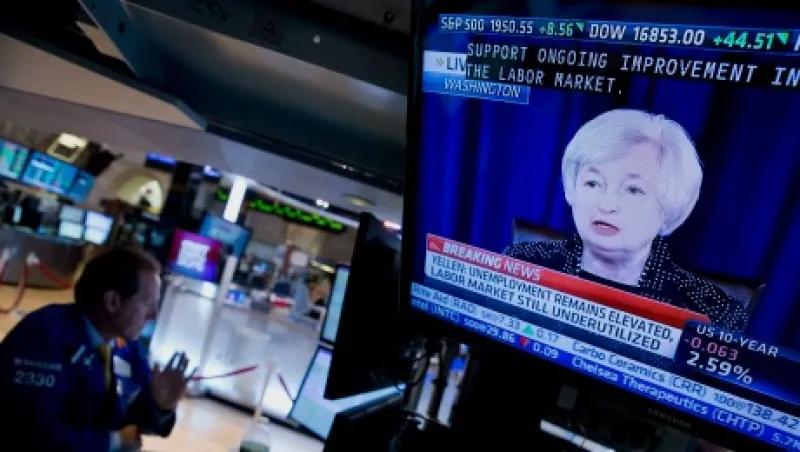Employment data reassures investors. U.S. July employment data, issued on Friday, did much to soothe anxious investors as a still-vulnerable labor market cements the argument for a slow pace of Federal Reserve withdrawal from quantitative easing and accommodative rates. Not everyone agrees that U.S. stocks have found a near-term bottom, however. In a note this morning, Nicholas Colas, chief market strategist with ConvergEx Group, a New York–based global brokerage firm that caters to institutional investors and financial intermediaries, compared investors in U.S. equity markets to gamblers flush with the casino’s money nervously eyeing the exit after last week’s sudden sell-off. “The old adage ‘selling begets selling’ feels true enough in markets with a lot of ‘house money’ on the line,” he writes.
Bank bailout in Portugal. The $6.6 billion rescue of Banco Espirito Santo announced by the Portuguese government over the weekend is seen as a test for European Union bank failure responses going forward. The lender will be divided into a so-called good bank, which will continue operations and secure deposits and a so-called bad bank, which will house troubled loans. Shareholders and bondholders will bear the losses resulting from the portfolio of distressed assets.
Earnings season continues. American International Group, Cardinal Health and Marathon Oil are among the large-cap U.S. equities reporting second-quarter 2014 earnings today. HSBC reported disappointing earnings this morning with a pretax contraction of 12 percent from the same period last year to mark the first half-year decline since 2009. In the report, HSBC, Europe’s largest bank, wrote that it will continue to exit unprofitable markets and geographies and rein in its levels of nonperforming loans.
Treasury markets remain calm, junk bond investors panic. A sharp increase in yields for lower grade U.S. corporate debt markets last week follows months of outflows for junk-bond exchange-traded funds and mutual funds, according to financial data firm Lipper. In a research note issued Friday, Barclays noted that no rush to the exit has commenced for bond investors as the Federal Open Market Committee (FOMC) signals suggest a later but faster pace for rising policy rates.
Credit concerns in China. The second-quarter 2014 report by the People’s Bank of China, released on Friday, indicated continued concern by the central bank over rapid credit growth and indicated that it will refrain from any monetary easing actions. “Our existing money supply and credit are already relatively large and their growth is also high,” the report stated, adding that “restructuring and reform of the economy remains an arduous task.”
Quiet day for macro. No major economic data points will be released today. The week ahead will bring Chinese trade data and rate decisions by the Bank of England and the European Central Bank.
Portfolio Perspective: Bees & Butterflies
Robert Savage, CCTrack Solutions
“Float like a butterfly, sting like a bee.” — boxer Muhammad Ali
While the pain of last week may still sting like a bee, the calls for a bigger, more painful correction fell apart Friday with a benign jobs report in the U.S. and many expect August to continue to be summer rather than a crueler, hotter and more volatile version of fall. Rate policy changing at the FOMC dominates markets globally, with geopolitical concerns from Russia to Gaza a close second. The actual growth rate in China, Japan and Europe rounds out the worry list for the month ahead. The simple fear continues to be how equity markets survive higher interest rates. Some of this falls back on risk-free models and the central bank interventions from 2008 making the value proposition for all markets opaque. The seasonal risks of change in August stand out with much of the financial world on vacation, as the headline chasing of economic and political risks percolate unattended. We started August with just such a move, closing last week down 2.7 percent, making it the worst outcome since June 2012. Nevertheless, fear measures like the VIX at 17.03 remains below 20, a flashpoint for risk reduction. So the logical question for the week is: What tips the market sentiment for the rest of August?
The first factor that seems to matter is divergence — the ability for the U.S. to raise rates in 2015 while Japan and Europe continue to ease. The U.S. dollar remains the barometer of choice for this factor and given its performance in July, it’s wise to be cautious in August.
The second factor is growth. The fears in the U.S. of a liquidity trap are highlighted by the reaction to weaker U.S. jobs. Bad news becomes good for stocks, a perversion of sustainability that exemplifies the addiction to Fed easy money. This reaction contrasts sharply to last week’s U.S. second-quarter 2014 gross domestic product surprise, when higher rates were justified by a stronger economy. The best measure for this mood is the U.S. yield curve — as the one-year to five-year (1y/5y) highlights the terminal rate for the FOMC. The barometer suggests that we are 2.5 to 3 percent for Fed funds — tops. A simpler way of watching this would be the December 2016 Fed funds futures.
Finally, we have the rest of the world. Here, emerging markets dominate as they seem most vulnerable to a position mismatch in 2014 with money flows supporting the former Fragile Five. The easiest way of measuring this risk remains equities and sovereign bonds.
So, whether we have a full summer or just a half may be simply a reaction function to the weather of news that hits the tape in the next few weeks. And we all know that shifts faster than traders can move positions — particularly junior ones stuck on the desk rather than on the beach.
Robert Savage is the CEO of CCTrack Solutions, a New York–based hedge fund firm. CCTrack is backed by Citic Capital Holdings, which in turn is backed by the sovereign wealth funds of China and Qatar.






